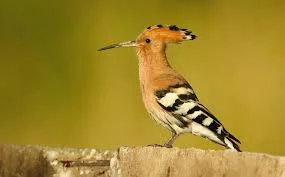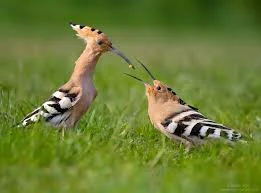The Eurasian hoopoe (Upupa epops) is a unique and fascinating bird, recognized for its colorful feathers, special crest, and charming sound. Found in Europe, Asia, and parts of Africa, this bird is loved by bird watchers.
Whether you’re thinking about keeping a Eurasian hoopoe or just want to help it stay healthy, we will share all the information you need to care for this amazing bird.
Understanding the Eurasian Hoopoe
Before learning how to take care of the Eurasian hoopoe, it’s important to understand where it lives, how it acts, and what it likes to eat.
Physical Appearance of Eurasian hoopoe:
The Eurasian hoopoe is a bird of medium size, with a long, curved beak. Its body is a soft orange-brown color, and its wings have black-and-white stripes. One of the most interesting things about this bird is its crest, which is a group of feathers on its head that can spread out like a fan when the bird is excited or feels threatened.
Natural Habitat of Eurasian Hoopoe:
The Eurasian hoopoe likes open areas like grasslands, savannas, and the edges of forests. It is often found in places like orchards (groups of fruit trees), vineyards (places where grapes grow), and gardens, where it can find lots of food. These places are good for the hoopoe because they have a mix of open land and trees, which is where the bird likes to be.
Behavioral Traits of Eurasian Hoopoe:
The Eurasian hoopoe is usually a solitary bird, meaning it likes to live alone, though it can also be found in pairs, especially when it is time to raise its young. This bird spends most of its time on the ground, using its long beak to look for food. It is good at finding insects, such as ants and beetles, which it digs up from the soil using its beak.
Setting Up the Perfect Home for a Eurasian Hoopoe
Making the right home for your Eurasian hoopoe is very important. If you are keeping one as a pet, its space should be as close as possible to its natural home so it can feel safe and happy.
Cage or Aviary Needs:
- Size: The cage or aviary should be big enough for the bird to move around easily. A good minimum size is 10 feet by 10 feet, but bigger is always better. More space means a happier bird.
- Material: Build the cage using strong wire mesh. This will keep the bird from escaping and protect it from animals that might try to harm it.
- Perches: Add several wooden perches of different sizes and heights. These give the hoopoe places to sit, rest, and climb. Make sure the perches are safe and made from natural wood.
- Ground Cover: Cover the floor with sandy soil or natural grass. This will let the bird dig and search for food, just like it does in the wild.
Temperature and Light:
Keep the temperature between 20 and 30°C (68-86°F). This will help the bird stay comfortable and healthy.
Place the cage outside or near a sunny window to ensure the bird gets natural sunlight. If that’s not possible, use special lights that work like sunlight to keep the bird healthy.
Shelter and Nesting:
Provide a nest box made of untreated wood. It should be large enough for the bird to move around and feel safe while resting or laying eggs.
Create quiet and hidden spots inside the cage, especially during the breeding season. This will give the hoopoe privacy and help it feel calm and safe.
Proper Food and Care for the Eurasian Hoopoe
Feeding your Eurasian hoopoe the right food is very important to keep it healthy and happy. Since these birds mostly eat insects in the wild, you should try to give them similar food when keeping them as pets.
Best Foods to Feed:
- Live Insects: The main food for the hoopoe should be live insects like mealworms, crickets, and beetles. These bugs give the bird important nutrients and help it eat like it would in nature.
- Extra Foods: You can also give the hoopoe foods like hard-boiled eggs, minced meat, and special bird food that has insects in it. These foods are helpful when you don’t have enough live insects to feed.
- Fruits and Vegetables: Even though insects are their main food, you can offer small amounts of chopped fruits like apples, berries, and soft fruits. These provide vitamins to keep the bird strong. Avoid citrus fruits like oranges, which can upset the stomach.
Water:
- Drinking Water: Always keep fresh, clean water available for the bird to drink. Make sure to change the water every day so it stays safe to drink.
- Bathing Water: Hoopoes enjoy taking baths. Place a shallow dish of water where the bird can splash and clean its feathers.
Feeding Tips:
- How to Serve Food: Put the food in shallow dishes or scatter it on the ground. This makes the hoopoe look for food like it would in the wild, keeping it active and happy.
- Changing the Diet: Change the amount of food depending on how active the bird is and the time of year. For example, during cold months or when the bird is raising chicks, it might need more food.
By giving your Eurasian hoopoe the right food and water, you can help it stay healthy, active, and content.
Health and Care for the Eurasian Hoopoe
Taking good care of a Eurasian hoopoe means watching its health closely and visiting the vet when needed. Keeping the home clean and safe is also very important to prevent sickness.
Common Health Problems:
Parasites: Hoopoes can get bugs like mites, lice, or worms that make them itchy and sick. Check for signs like scratching a lot, losing feathers, or looking weak. Regular checks can help catch problems early.
Injuries: Since hoopoes are active and often search for food on the ground, they can hurt their wings or legs. Look for signs like limping, not being able to fly, or swelling. If you notice these, get help from a vet right away.
Poor Diet: If the bird doesn’t get the right food, it can become weak or sick. Make sure it eats enough healthy foods like insects, eggs, and fruits to stay strong and full of energy.
How to Keep the Bird Healthy:
Vet Check-ups: Take your hoopoe to a bird doctor (avian vet) at least once a year. This can help find any hidden health problems early before they become serious.
Clean Living Space: Keep the bird’s home clean by removing food scraps, waste, and dirty water every day. Clean the cage regularly to keep germs and bugs away.
Separate New Birds: If you get a new bird, keep it in a different cage for a few weeks before letting it join other birds. This helps prevent the spread of diseases.
By following these simple steps, you can keep your Eurasian hoopoe healthy, happy, and safe from illnesses.
Breeding and Raising Baby Hoopoes
Breeding Eurasian hoopoes can be both difficult and fun, especially for people with experience caring for birds. With the right care, hoopoes can raise chicks successfully.
Breeding Time:
- Hoopoes usually breed from April to July.
Making a Nest Box:
- Good Nest Box: Use a wooden box with a small entrance hole to keep the nest safe.
- Cozy Nest: Line the box with dry grass or leaves to make it warm and comfortable.
Caring for Baby Birds:
- Feeding Chicks: Give the parent birds protein-rich food like insects to feed their chicks.
- Keep Them Safe: Watch the chicks as they grow and make sure they are safe and healthy.
Legal and Moral Responsibility
Before keeping a Eurasian hoopoe, it’s important to know the rules and act responsibly.
Know the Rules:
- Check Local Laws: Some countries don’t allow people to keep wild birds, so learn what is allowed where you live.
Be Responsible:
- Help Nature: Support bird protection programs to help wild hoopoes survive.
- Don’t Catch Wild Birds: Never take birds from the wild. Only get them from certified breeders.
Conclusion
Caring for a Eurasian hoopoe takes time, effort, and love for birds. Whether you are a bird lover or someone interested in protecting wildlife, following these tips will help hoopoes live healthy and happy lives.
By understanding their needs and giving them proper care, you can enjoy these beautiful birds while helping to protect their species for the future.



